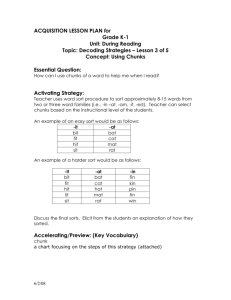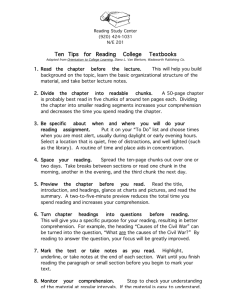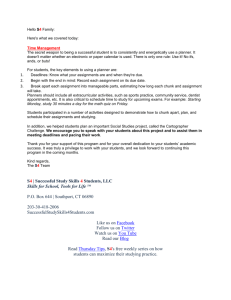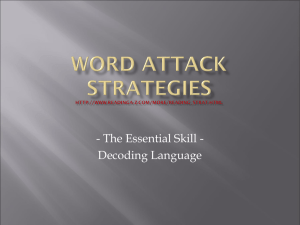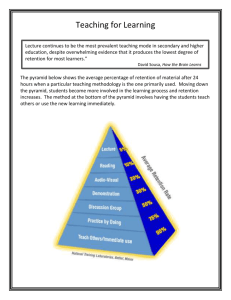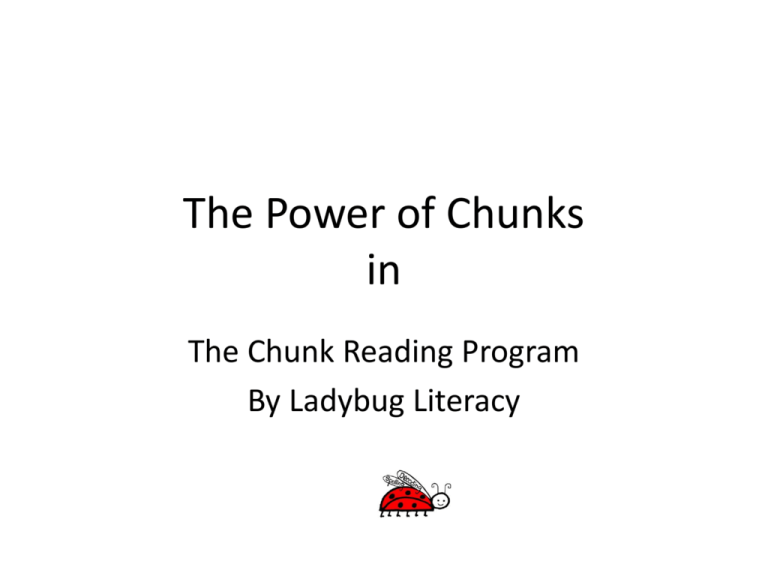
The Power of Chunks
in
The Chunk Reading Program
By Ladybug Literacy
Phonemic
Awareness
The Alphabetic Principle
Phonemic Awareness — Matching Letters with Sounds
Researchers “sound in” on Phonemic Awareness:
Juel, 1988: Juel found that phonemic awareness is an important
precursor to reading success.
Yopp and Yopp: found that phonemic awareness correlates with
reading success.
Our program builds phonemic awareness with the Blend Listen and
Spell Game, and the Chunk Listen and Spell Game (see slide 15)
The Chunk Phonics Curriculum
Based on analogies: if a student knows cat s/he can figure out sat, hat, etc. and s/he
can recognize at in long words with many syllables.
Phonemic Segmentation
• Blends and Digraphs
• Multisensory learning of 64 common CHUNKS/Rimes and
patterns.
• Each CHUNK has a memorable "helping word“ illustrated with
a vivid, colorful photo
Why analogies?
Marilyn Adams (1990) tells us that letter-sound correspondences are
more stable when one looks at rimes than when letters are looked at in
isolation.
She noted that of 286 phonograms that appear in primary grade texts,
95% of them were pronounced the same in every word in which they
appeared.
Fry’s Second 100 Words
Fry’s First 100 Words
Unique Teaching Resources ©All Rights Reserved
Unique Teaching Resources ©All Rights Reserved
1. the
2. of
3. and
4. a
5. to
6. in
7. is
8. you
9. that
10. it
11. he
12. was
13. for
14. on
15. are
16. as
17. with
18. his
19. they
20. I
21. at
22. be
23. this
24. have
25. from
26. or
27. one
28. had
29. by
30. words
31. but
32. not
33. what
34. all
35. were
36. we
37. when
38. your
39. can
40. said
41. there
42. use
43. an
44. each
45. which
46. she
47. do
48. how
49. their
50. if
51. will
52. up
53. other
54. about
55. out
56. many
57. then
58. them
59. these
60. so
61. some
62. her
63. would
64. make
65. like
66. him
67. into
68. time
69. has
70. look
71. two
72. more
73. write
74. go
75. see
76. number
77. no
78. way
79. could
80. people
Fry’s Third 100 Words
81. my
82. than
83. first
84. water
85. been
86. called
87. who
88. am
89. its
90. now
91. find
92. long
93. down
94. day
95. did
96. get
97. come
98. made
99. may
100. part
101. over
102. new
103. sound
104. take
105. only
106. little
107. work
108. know
109. place
110. years
111. live
112. me
113. back
114. give
115. most
116. very
117. after
118. thing
119. our
120. just
121. name
122. good
123. sentence
124. man
125. think
126. say
127. great
128. where
129. help
130. through
131. much
132. before
133. line
134. right
135. too
136. means
137. old
138. any
139. same
140. tell
141. boy
142. following
143. came
144. want
145. show
146. also
147. around /around
148. farm
149. three
150. small
151. set
152. put
153. end
154. does
155. another
156. well
157. large
158. must
159. big
160. even
161. such
162. because
163. turn
164. here
165. why
166. asked
167. went
168. men
169. read
170. need
171. land
172. different
173. home
174. us
175. move
176. try
177. kind
178. hand
179. picture
180. again
181. change
182. off
183. play
184. spell
185. air
186. away
187. animals
188. house
189. point
190. page
191. letters
192. mother
193. answer
194. found
195. study
196. still
197. learn
198. should
199. America
200. world
Unique Teaching Resources ©All Rights Reserved
201. high
202. every
203. near
204. add
205. food
206. between
207. own
208. below
209. country
210. plants
211. last
212. school
213. father
214. keep
215. trees
216. never
217. started
218. city
219. earth
220. eyes
221. light
222. thought
223. head
224. under
225. story
226. saw
227. left
228. don’t
229. few
230. while
231. along
232. might
233. close
234. something
235. seemed
236. next
237. hard
238. open
239. example
240. beginning
241. life
242. always
243. those
244. both
245. paper
246. together
247. got
248. group
249. often
250. run
251. important
252. until
253. children
254. side
255. feet
256. car
257. miles
258. night
259. walked
260. white
261. sea
262. began
263. grow
264. took
265. river
266. four
267. carry
268. state
269. once
270. book
271. hear
272. stop
273. without
274. second
275. later/later
276. miss
277. idea
278. enough
279. eat
280. face
281. watch
282. far
283. Indians
284. really
285. almost
286. let
287. above
288. girl
289. sometimes
290. mountains
291. cut
292. young
293. talk
294. soon
295. list
296. song
297. being
298. leave
299. family
300. it’s
Did you know???
Fry’s first 300 sight words:
• 171 of these contain chunks from our
program (many words have more than
1 chunk)
• In addition, many are covered by the
silent-e rule
• Students can apply program strategy
of analogies to remember many (e.g.
be, me, we, he, she + could, would,
should etc.)
“For ELLs, who are learning to read in an inconsistent orthography like
English, instruction using analogy-based phonics provides children an
additional strategy for reading a larger number of words as they are building
their English oral language skills.
-- Sylvia Linan-Thompson and Sharon Vaughn
(based on data from Blevins, 1998; Center for the Improvement of Early Reading Achievement
[CIERA], 2001; NRP, 2000; Texas Education Agency [TEA], 2000).
More about analogies later…
“…analogies based on rime are easier than those that cut
across onset and rime.
“…Analogies are a natural and important part of
children’s reading and spelling. They are made by old and
young children alike—by older children who know how to
read and write a great number of words and by young
children who can read hardly any words and spell even
fewer. These beginning readers are ready to make
analogies even though they know so few written words
and therefore have such a small basis for making any
analogies at all. Nevertheless, they apply their awareness
of rime, and their obvious capacity to make inferences, to
the business of learning how to read and spell new
words.” – Goswami and Bryant (1990)
The program teaches chunks in a variety of ways!
“Multisensory Mapping uses all modalities (auditory, visual,
kinesthetic-tactile) to facilitate retention and processing of
sounds. Research confirms that the most common barrier
to acquisition of emergent reading skills is the inability to
process phonologically.”
--Based on research of Snow, Burns, & Griffin, 1998
In this program, students manipulate magnetic letters, recite chunks on
the posters by chanting, singing, and doing hand motions to form a
memory trace, and they also get lots of practice reading and writing the
chunks in new words.
Lead-in activity to Match-O:
• Listen to the mystery word
• Find the helping word that
sounds the same
• Write the new word in the grid
• Make sure the letters match
• Decoding marks help
teacher see how student is
processing a word.
•
Strong visuals
•
Photos, not drawings
•
Concrete helping words
•
Diversity in images
•
All short vowels are represented
•
“Silent e” appears in 3 chunks
•
Students recognize many images
and words from ABC and Blend
charts (e.g. cat, stop, slide, moon,
etc.)
•
Reinforcing Blends and Digraphs via
Chunk Charts
•
Multisensory mapping of chunks
through visuals, chanting, cheering,
and breaking words with their voice
Students have an easier time recognizing a word part when you change the onset
than when you change the end.
Easy for students
Difficult for students
The program deals with this difficulty by teaching students how to extend the chunks in
one of the nine core lessons.
• Soft c rule illustrated
• Silent e reinforced
(-at vs. –ate)
• Two vowels rule (ai, ea)
• 9 chunks offer good practice
for dropping and changing
last part of a chunk
• Review of two vowels rule
• 2nd sound of –ow
(cow vs. snow)
• 2nd sound of -oo
(moon vs. book)
• Pattern -ture
• 10 chunks offer good practice
for dropping and changing last
part of a chunk
• 5 chunks ending in k push
students to discriminate
between patterns by mentally
dropping the last letter
• Revisit silent -gh
(-ight & -aught)
• Pattern: –tion
• 2nd sound of –ea
(meat vs. bread)
• Revisit soft c / soft g rule
(badge)
• Pattern –dge is taught through
the rime or chunk –adge
• Mix of hard and easy concepts
keeps students confident as
they master new reading skills
Just as students must know their ABCs by heart, they
must also know the common letter patterns, or chunks,
in order to be efficient readers.
“Learning to convert letters to recognize words requires
knowledge of the relation between sounds and letters or other
symbols that represent them, then remembering the exact
patterns and sequences that may represent various speech
sounds.”
--Goswami 2006
The program reinforces this skill primarily through the Match-O Game.
Teach Decoding with Match-O Game
The workhorse of the program!
•
•
•
•
Introduce students to new words with 5 Leveled Lists for each CHUNK Chart
About 75% of list words are encountered again in the stories
Students reference their knowledge of Chunks to spell new words
Match-O grids help students focus on which letter patterns represent which sounds
Students light up the chunk, find the match in their grid, and write the new word
under the helping word, taking care to line up the parts that match. The grid is laid
out in the same order as the chart.
Words get more complex with each level, but students know if they “chunk it out” they
can read it!
Lists are made up of productive words pulled from content, academic word list,
synonyms, adjectives
Leveled Word Lists 1 - 5 for Chunk Chart 1
Writing Practice
The Chunk Reading Program provides
students opportunities to spell words
and write their own stories with the
letter-sound relationships they are
learning.
There is a writing exercise for every chunk in the program
“In addition [to an analogy-based phonics approach] the program should
include books and stories that contain a large number of words that
children can decode by using the letter-sound relationships they have
learned and are learning.”
-- Sylvia Linan-Thompson and Sharon Vaughn
The Chunk Reading Program includes 24 stories with decodable text from
different genres. All stories include comprehension activities that require
some writing. The stories get longer and more complex as the students
master more chunks. The most challenging story is about middle of 3rd
grade level.
By the time students have done the activities for all 4 Chunk Charts, they
easily move on to stories outside our program!
E
l
e
m
e
n
t
s
o
f
T
e
x
t
Cover
Sample Chapter and
Comprehension
Questions
Student does
illustrations
Table of Contents
Credits on Back!
Assessment: Monitoring Students’ Learning
• pre/post test (3 levels)
• Assessment built into each lesson
• daily check in with Match-O
• daily reading of Leveled Lists
• story comprehension questions
Routines and consistent language help students remember
Bolded language prompts act as
“think-alouds”
Assessment is built into every lesson!
Thank you!
www.ladybugliteracy.com
651-558-1030

